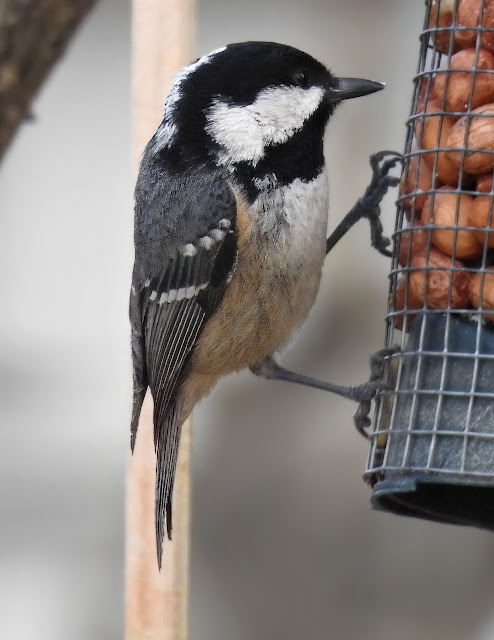This Blog contains Wildlife, Plants and Bird Photos from Walks, Safaris, Birding Trips and Vacations. Most of the pictures have been taken with my Nikon P900 and P950X cameras. Just click on any image for a larger picture. On the right column under the Blog Archive are the entries by date. Below that under Animal categories all the diffent species of Animals, Birds, Insects and Plants contained in the website are listed. Clicking on any entry will show all the entries for that species.
TOTAL PAGEVIEWS
TRANSLATE
Friday, 17 February 2023
Thursday, 16 February 2023
Wednesday, 15 February 2023
Tuesday, 14 February 2023
19-12-2015 JURONG, SINGAPORE - WHITE WINGED DUCK (Asarcornis scutulata)
The white-winged duck or white-winged wood duck (Asarcornis scutulata) is a large species of duck, formerly placed in the genus Cairina with the Muscovy duck (Cairina moschata) and allied with the dabbling ducks. However, mtDNA cytochrome b and NADH dehydrogenase subunit 2 sequence analysis indicate that the anatomical similarity to the Muscovy duck is deceiving and that the species is appropriately placed in a monotypic genus, as Asarcornis scutulata, which is evolutionarily closer to the redhead (Aythya americana, one of the diving ducks).
Historically, the white-winged duck was widely distributed from northeastern India and Bangladesh, throughout South East Asia to Java and Sumatra. It is now extinct in Java. In India, the duck is found only in the northeastern part of the country, with the main concentration in eastern Assam and adjacent areas of Arunachal Pradesh. However, in 2002 it had a population of only 800, with about 200 in Laos, Thailand, Vietnam and Cambodia, 150 on Sumatra, notably in Way Kambas National Park and 450 in India, Bangladesh and Burma.
In India, the key protected areas for the white-winged duck are Dibru-Saikhowa National Park, Dihing-Patkai Wildlife Sanctuary, Nameri National Park and Namdapha National Park.
The white-winged duck occurs in dense tropical evergreen forests, near rivers and swamps.
They tend to nest in tree cavities, and are threatened in part since the destruction of hollow trees is destroying their nesting localities. The draining of swamps and rivers and other forms of habitat destruction is also destroying the habitat that they could survive in. Additional threats include loss of genetic variability, disturbance, hunting, and collection of eggs and chicks for food or pets.
Monday, 13 February 2023
Sunday, 12 February 2023
12-2-2023 ADOR CAMPO, VALENCIA - ZITTING CISTICOLA (Cisticola juncidis)
The zitting cisticola is 10 to 12 cm (3.9 to 4.7 in) in length. It is brown above, heavily streaked with black markings. The underparts are whitish, and the tail is broad, white-tipped and flicked frequently, giving rise to the alternative name for the species. The adult males have less crown streaking and more back marking than the females, but there are no great difference between the sexes or the eighteen geographical races. The absence of a nuchal collar separate it from the golden-headed cisticola (Cisticola exilis ). In the non-breeding season, they tend to skulk within the grass and can be hard to spot.
This species is found mainly in grassland habitats, often near water. Most populations are resident, but some East Asian populations migrate south to warmer areas in winter. In the Himalayas, they ascend to about 1,900 m (6,200 ft) during summer but are below 1,300 m (4,300 ft) in the winter. This species is a rare vagrant to northern Europe, mostly as a spring overshoot. Its European range is generally expanding, although northern populations are especially susceptible to hard winters.
Zitting cisticolas are very small insectivorous birds, sometimes found in small groups. The breeding season is associated with the rains. Two broods a year occur in many regions. Males are generally polygynous, but some are monogamous. The male builds the initial nest structure deep in the grasses, and invites females using a special display. Females that accept the male complete the nest. The nest is made by binding living leaves into the soft fabric of felted plant-down, cobwebs, and grass. The zitting cisticola's nest is a cup shape with a canopy of tied-together leaves or grasses overhead for camouflage; 3–6 eggs are laid. The female incubates the egg. The eggs hatch after about 10 days. More than one brood may be raised. Females change their mates frequently and rarely stay within the same territory, while males are less mobile, maintaining non-overlapping song-territories which shift from day to day. Females can sometimes breed in their first year.
Saturday, 11 February 2023
Friday, 10 February 2023
Thursday, 9 February 2023
Wednesday, 8 February 2023
Tuesday, 7 February 2023
Subscribe to:
Comments (Atom)












%202.jpg)



%201.jpg)
%202.jpg)
%203.jpg)
%204.jpg)




%202.jpg)
%203.jpg)
%206.jpg)
%207.jpg)


%201.jpg)


%201.jpg)
%202.jpg)





%201.jpg)
%201.jpg)
%202.jpg)






%201.jpg)
%202.jpg)